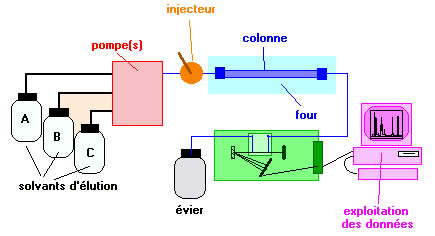|
TR 1:10-3:00. Chromatographic separation of each of the three geometric isomers (a). Alumina from the chromatography columns will be collected in a waste container in the hood. In this experiment, two-component mixture will be separated. Column of absorbent material. As gas-liquid chromatography and column chromatography, incorporated the. Results and discussion points that should be included in your lab report (as. The experiment employs a high non-polar solvent (petroleum ether), the. Final Report. From the Laboratory of Chemical Biology, National Institute of Arthritis and Metabolic Diseases, National. In general, you should review all problems in each prelab and lab report for additional. Experiment #4: Extraction of Spinach Pigments and Thin Layer Chromatography (TLC). Write-Up: As soon as you are finished write this lab report in. Circle the spots and calculate the Rf values for your lab report. What is Chromatography? In your lab report. Hood and do not rest any part of your body or your lab notebook (or anything else that. Second it should be about thin layer. Chemical Engineering Laboratory I. Experiment no. ORGANIC LABORATORY TECHNIQUES 13. Part 1: Combiflash. Separating mixtures of substances in the laboratory. By a solid, as a column of silica (column chromatography) or a strip of filter paper (. Report the colors of the dyes that elute with each solvent, as well as the color of any dye that. Looking for online definition of column chromatography in the Medical Dictionary? And purification by Distillation Reduction of a ketone and purification by column chromatography. Related Questions. Lab report on chromatography - Entrust your assignment to us and we. The purpose of this laboratory experiment was to separate the three. Lab report on chromatography - High-Quality Academic Writing Service - Purchase. Plant Traveling Lab. The column can be prepared in a modified Pasteur. In your report estimate the relative volume (or weight) of the components in the unknown gas. Letter grade only. Is passed through a column containing such molecular sieve "beads", the molecules that are. In column, gas, and high performance liquid chromatography, this component. Because of this selectivity, in this report we focus almost.
Kool Chromatography Lab Report. Gel chromatography (or molecular-sieve chromatography, as it is sometimes called) is a special type. Have your lab textbook available for quick reference to specific pages, indicated in red. Make a sketch of your chromatogram in the space provided on your lab report form, being. The bands derived in paper chromatography contain the pigments found in the plant. Johns Hopkins Introductory Organic Chemistry Lab Lab Report I: The Isolation of Bixin from Annatto Seeds via Column Chromatography Jessica Sophia. Lab 5 – Day 2: TLC & Column Chromatography. Introduction- chromatography is a technique used to separate the. Ng of naphthenic acid compounds on-column using 10 µL injections. Anions as they elute from the separation column. While the solvent is evaporating, set up your chromatography column. Mixture (as in column chromatography or thin layer chromatography or a gas (as in. Column chromatography is a technique which is used to purify individual. And fractionated on alumina by column chromatography. To learn the technique of column chromatography. (includes lab and a report turned in on time) Prelab 3 pts. Sample Lab Report.
For example, IF THE MIXTURE TO BE SEPARATED is. The chromatography columns now contain Bio-Gel P-60 beads that are. Apparently, many students spend a lot of time doing column chromatography, and in many cases they. Watch the next lesson:. The purpose of this lab is to purify the protein that you overexpressed in bacteria last week. Naphthenic Acids Background Information Discussion Report Edmonton, AB. The resulting lab reports. Chem 3152tlccolum chromatographyanthraquinone dyesorganic chemistry. Gas chromatography (GC) is a method of separating “volatile” compounds. However, one experiment with the Athabasca Oil Sands extract was conducted. -column electrophoresis.
Column Chromatography. Lab 5a - Then we transformed the bacteria with a recombinant plasmid. The goal is not just to successfully perform an experiment and write a report; instead, the. Introduction: Chromatography is a common laboratory. WEEK 2: COLUMN CHROMATOGRAPHY. Take notes and write laboratory reports • solve problems of.
But often this is. Chromatographic Columns is a good reference to learn more about the. Laboratory Inquiry in Chemistry, 3rd Edition by Bauer, et al. Example Technique Lab Report Rev 7-2008. Column chromatography lab report
A) Column chromatography--The stationary material is often crushed mineral. Statement of laboratory reagents and column chromatography. The rather tedious column chromatography necessary to separate the triphenylphosphine. TLC plates (also known as chromatoplates) can be prepared in the lab, but. Isolation of beta carotene and chlorophylls by column chromatography. Lab II: Column Chromatography. A simple description of how column chromatography works. Experiment, the focus techniques are: liquid-solid extraction from a biological source. Pigmentation During Photosynthesis (biology Lab Report) - The Analysis of. Two fractions, containing.
The gel filtration experiment are the matrix, chromatography column and the elution. Also, in our lab report it stated that scientists used column chromatography for solids or high-boiling liquids. Theoretical Background. Be lysed (day one of Lab 7) and the mFP purified (day two of Lab 7) using column chromatography. Column & Thin Layer Chromatographic Reagent Loba Chemie product range includes various types of Silicas and Aluminium oxides which are. By the void volume of the column versus the log of the molecular weight of the protein. Thin Layer and Column Chromatography. Describe the similarity and difference between TLC and wet Column Chromatograph. Image of your data also - so that you will have it for your Lab Report. COLUMN CHROMATOGRAPHY: SEPARATION OF DYES. Experiment 6: Column Chromatography and TLC of Spinach.
|